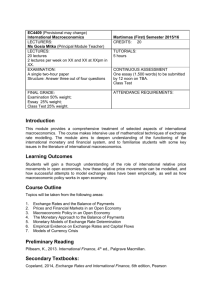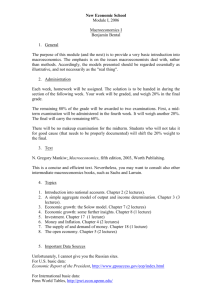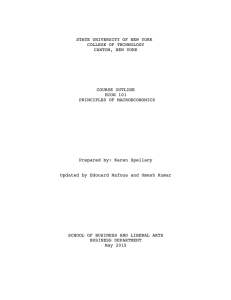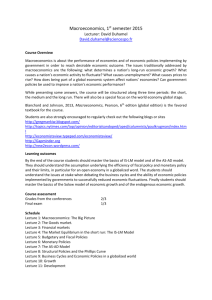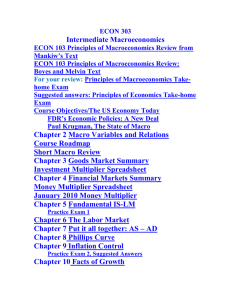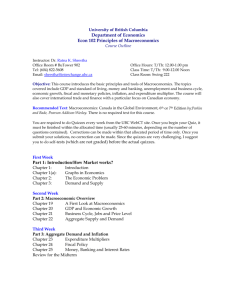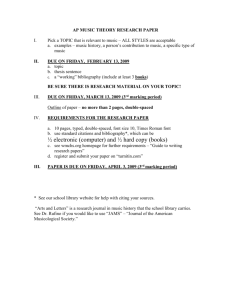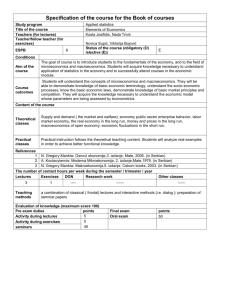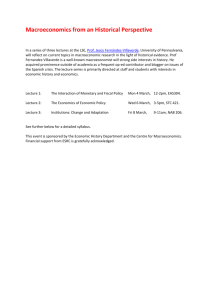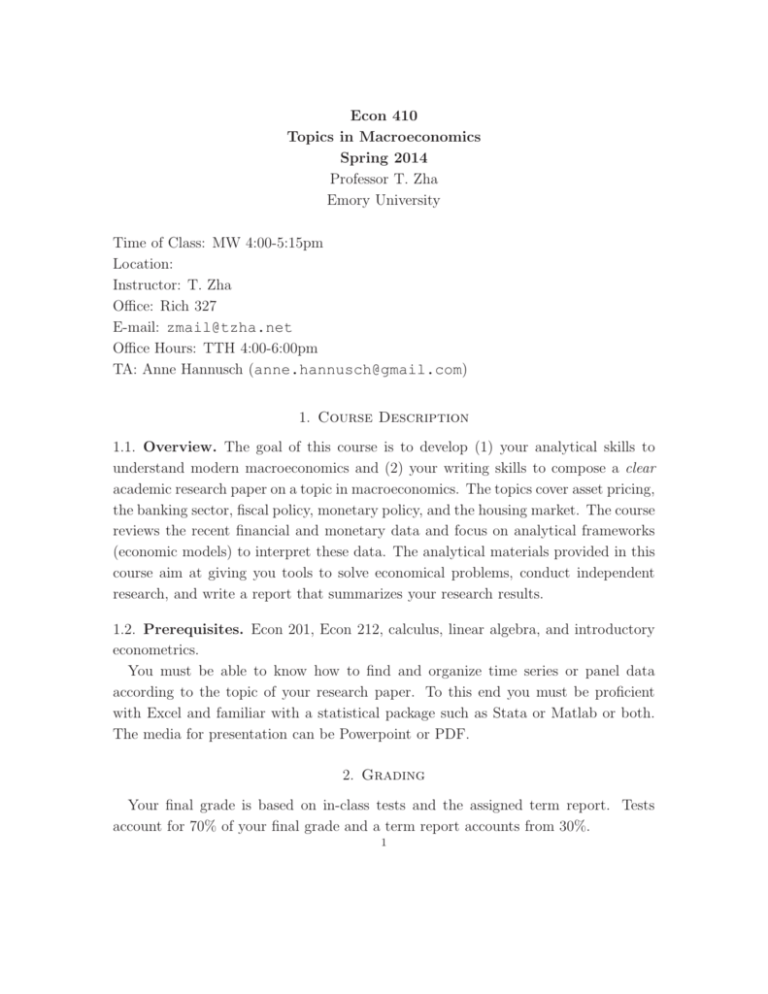
Econ 410
Topics in Macroeconomics
Spring 2014
Professor T. Zha
Emory University
Time of Class: MW 4:00-5:15pm
Location:
Instructor: T. Zha
Office: Rich 327
E-mail: zmail@tzha.net
Office Hours: TTH 4:00-6:00pm
TA: Anne Hannusch (anne.hannusch@gmail.com)
1. Course Description
1.1. Overview. The goal of this course is to develop (1) your analytical skills to
understand modern macroeconomics and (2) your writing skills to compose a clear
academic research paper on a topic in macroeconomics. The topics cover asset pricing,
the banking sector, fiscal policy, monetary policy, and the housing market. The course
reviews the recent financial and monetary data and focus on analytical frameworks
(economic models) to interpret these data. The analytical materials provided in this
course aim at giving you tools to solve economical problems, conduct independent
research, and write a report that summarizes your research results.
1.2. Prerequisites. Econ 201, Econ 212, calculus, linear algebra, and introductory
econometrics.
You must be able to know how to find and organize time series or panel data
according to the topic of your research paper. To this end you must be proficient
with Excel and familiar with a statistical package such as Stata or Matlab or both.
The media for presentation can be Powerpoint or PDF.
2. Grading
Your final grade is based on in-class tests and the assigned term report. Tests
account for 70% of your final grade and a term report accounts from 30%.
1
2
• There is a total of 13 tests to be given in class. You have 25 minutes to complete your answer for each test. Test days are chosen randomly without advance notice.
Only 10 tests with the highest scores are used for your final grade. If you
miss class when a test is given, you will receive no credit for that particular test. This rule will allow you to miss up to 3 tests during the semester.
No make-up test will be made available for any reasons.
• The length of the term report must be between 5 and 10 pages (double-spaced,
12-point font), excluding tables, graphs, references, as well as the title page
that contains an abstract. There is no restriction on the number of pages for
the tables, graphs, and references. The report must have a succinct abstract.
3. Honor Code
The honor code is in effect throughout the semester. By taking this course, you
affirm that it is a violation of the code to cheat on exams, to plagiarize, to deviate
from the teacher’s instructions about collaboration on work that is submitted for
grades, to give false information to a faculty member, and to undertake any other
form of academic misconduct. You agree that the teacher is entitled to move you to
another seat during examinations, without explanation. You also affirm that if you
witness others violating the code you have a duty to report them to the honor council.
4. Textbook
Stephen D. D. Williamson (2010): Macroeconomics (Prentice Hall, 4th Edition).
This textbook is optional.
5. Other References
You may find the following references useful.
• The Federal Reserve Bank of Atlanta: Author’s Guide (reserved in the library).
• William Strunk Jr. and E.B. White (1979): The Elements of Style (MacMillan
Publishing, 3rd edition).
• Marcia Stigum and Anthony Grescenzi (2007): Stigum’s Money Market (McGraw Hill, 2nd edition).
• John H. Cochrane (2001): Asset Pricing (Princeton University, revised edition).
3
• Adrew B. Abel, Ben S. Bernanke, and Dean Croushore (2008), Macroeconomics (Pearson Addison Wesley, 6th edition).
• Various articles, lecture notes, and slides (to be stored in Dropbox).
6. Topics
I provide extensive lectures on each of the following four topics. These lectures
aim at developing your analytical skills. All in-class tests are solely based on these
lectures.
(1) Asset pricing – a two-period model (Chapter 1, Cochrane 2001).
(2) Credit spreads and fiscal policy – a two-period simple model (the article to be
distributed).
(3) Housing prices and Sharp ratios – a static model (the article to be distributed).
(4) Understanding the money market and the term structure (slides and articles
to be distributed; see also Stigum and Crescenzi (2007)).
(5) Understanding the current financial crisis and the role of monetary and fiscal
policies (slides to be distributed).
7. Deadline for Turning in Your Term Report
The deadline for turning in your report is 4:00pm on May 5, 2013 (Monday).
Please hand in your report to Marie Browne in Room 306 of Rich Building. Any
report that will be turned in later than this deadline will receive zero credit. No
exception will be made.
8. Instructions for Writing a Report
The report will be graded based on its content, its style, and its expository clarity.
Make sure to check the spelling and the grammar of your report before submission.
• The report must be typed and double-spaced, with a font of 12 points (except
for the title page, see below).
• The report must have the following sections, in the same order:
(1) An abstract (10%). A brief synopsis of the report, not to exceed 150
words, placed in the title page (11 point font and 1.5 line spacing). The
rest of the report should start on a new page and should be typeset with
12 points and double-spaced.
4
(2) An introduction (20%). What questions does the report try to answer?
Why is it important? What has been done in the literature? What
is the unique contribution of your report? In addition, explain briefly
(typically in a short paragraph at the end of the introduction section)
how the presentation of the report is organized.
(3) A survey of the relevant literature (10%). Summarize the key articles
relevant to your topic and ideas. In some cases, you may combine this
section with the introduction.
(4) A clear description of your contribution (20%). If the report focuses on
empirical analysis, this section should bear a title such as “Data and
Methodology,” and should describe the sources of the data and the statistical or economic methodologies used to analyze the data. If you are
proposing a theoretical model, this section should have a title such as
“The Model,” and should give the details of the model’s structure and
solution methods.
(5) A summary of results (15%). Present the main results of the report.
Make sure that the presentation is precise enough so that anyone reading
your report should be able to replicate your results by using the same
data and the same methodology.
(6) A conclusion (15%). Briefly summarize what has been done in your report
and what you think should be done in the future along the line of research
that you have considered.
(7) A list of tables and figures (5%). They must be clearly labeled and
numbered.
(8) A list of references (5%). They should be formatted according to examples
I will given in the class.

